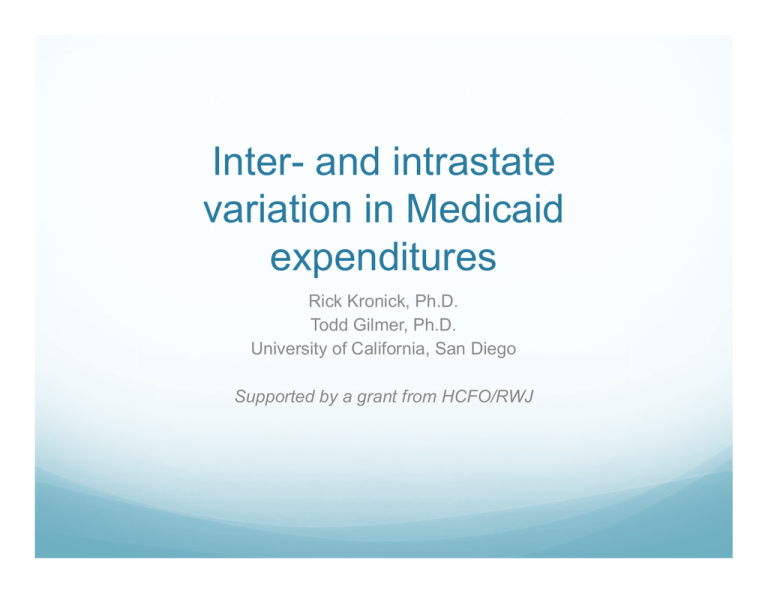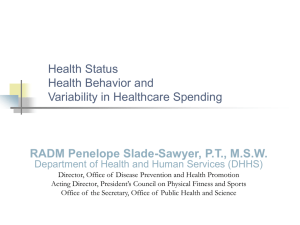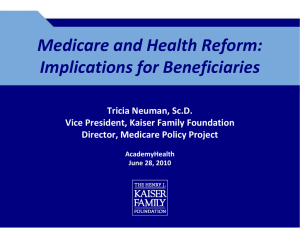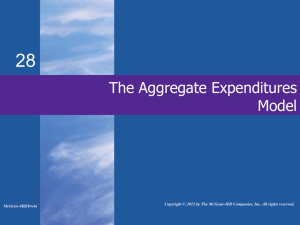Inter- and intrastate variation in Medicaid expenditures Rick Kronick, Ph.D.
advertisement

Inter- and intrastate variation in Medicaid expenditures Rick Kronick, Ph.D. Todd Gilmer, Ph.D. University of California, San Diego Supported by a grant from HCFO/RWJ Research Questions Does interstate variation in Medicaid spending result primarily from variation in the volume of services or in the price per unit of service? How do inter- and intrastate variation in Medicaid utilization and spending compare to variation in Medicare spending and utilization? Is more better for Medicaid beneficiaries? Data Medicaid Analytic eXtract (MAX) data for CY 20012005 for all 50 states and DC MAX data starts with data from the Medicaid Statistical Information System (MSIS), and is then massaged by CMS to create person-level person level analytic files Complete claims and eligibility data on approximately 280 million beneficiaries (not necessarily unique) over five years Methods Exclude partial benefits beneficiaries (SLMBs, QMBs, family planningonly, etc) Focus on Cash Cash-Assistance, Assistance Medicaid-Only, Medicaid Only fee fee-for-service, for service beneficiaries with Disabilities (CAMODs) – Restrict to cash disabled because uniform national eligibility standard for SSI increases comparability of the analysis sample across states – Restrict R t i t to t Medicaid-only M di id l ((eliminate li i t d duall eligibles) li ibl ) tto gett a complete l t view i of utilization and expenditures – Restrict to FFS because encounter data are incomplete for beneficiaries in managed care In analyses of spending on CAMODs, exclude five states (AL, AZ, DE, MD, and ND) because managed care penetration is too high or other data anomalies Distribution of Medicaid Beneficiaries and Expenditures, 2001‐2005 Beneficiaries Total Expenditures Acute LTC 47.2 million $234.6 billion $149.2 billion $74.8 billion Cash Assistance, Medicaid‐only, Disabled (CAMOD Other disabled Aged Adults Children Correlation Coefficients, State-level Expenditures per Beneficiary and Expenditures per CAMOD, 2001-2005 ndardized expenditures per beneficiary enditures per CAMOD te expenditures per CAMOD C expenditures per CAMOD Standardized Expenditures per Beneficiary 1.00 0.86 0.81 0.81 Expenditures per CAMOD Acute expenditures per CAMOD LTC expenditures per CAMOD — 1.00 0.96 0.93 — — 1.00 0.81 — — — 1.00 urce: 2001-2005 MAX data. N=46 (excludes AL, AZ, DE, MD, and ND). RESULTS Distribution of State‐level per Beneficiary Acute and LTC Spending on CAMODs, 2001–2005 Distribution of State‐level per Beneficiary Acute Care Medicaid Spending on CAMODs, 2001–2005, by Type of Service The relationship between Medicare and Medicaid utilization and spending Distribution of state‐level 2004 Medicare spending per beneficiary, and 2001‐2005 acute care Medicaid spending per CAMOD 2004 Medicare spending per beneficiary and 2001‐2005 acute care Medicaid spending per CAMOD 2004 Medicare admissions/1,000 and 2001‐2005 Medicaid admissions per CAMOD 2004 Medicare Part B spending, and 2001‐2005 Medicaid 'Part B' spending 2004 Medicare spending per beneficiary and 2001‐2005 acute care Medicaid spending per CAMOD, by HRR, selected states 2004 Medicare spending per beneficiary and 2001-2005 acute care Medicaid spending per CAMOD, by HRR, California HRR-level regressions on selected outcomes Medicaid Hospital Stays 30 Day Readmissions e Hospital Stays d Hospital Stays +++ n/a are Beds / 1000 ysician Visits Ambulatory Care Sensitive Hospitalizations Diabetes COPD CHF Asthma n/a +++ n/a +++ n/a n/a +++ n/a +++ ----- +++ +++ ++ +++ --- armacy Fills rugs ns per 1,000 of MDs in primary ++ +++ ed 0.39 +++ --0.53 +++ + ++ +++ ++ + +++ -- --- -- --- 0.45 0.21 0.47 0.68 - p < 0.01 p < 0.05 p < 0.10 essions are HRR-level regressions, and all Medicaid variables are measured on cash-assistance, Medicaid-only, FFS d, using MAX data from 2001-2005. Table entries show significance level and direction of the parameter estimates. spitali ations are spitalizations a e measured meas ed among beneficiaries beneficia ies with ith the diagnosis (diabetes, (diabetes COPD, COPD etc.) etc ) during d ing a CY period. pe iod Conclusions There is wide variation across states in spending per Medicaid beneficiary For example, NY spends more than twice as much per beneficiary than CA on acute care Spending is generally lower in the South, and higher in the Mid Atlantic New England Mid-Atlantic, England, and the upper Midwest Inpatient utilization only partially follows the contours of acute care spending p g Low in New England; high in FL, LA, TX, and OK There is much more interstate variation in mental health and ‘other acute’ spending than in inpatient, MD/OPD/Clinics, or Rx, and much more variation in LTC than in acute spending Volume of services drives relative positioning, unit price is secondary High-spending and low-spending states are different from the national average primarily because of volume (2/3), and only secondarily because of price (1/3) Inpatient, mental health, and other spending contribute approximately i l equally, ll while hil variation i i iin MD/OPD/Cli MD/OPD/Clinic i has very little effect Inpatient p spending p g varies approximately pp y equally q y because of volume and price, while MH and drugs variation is driven almost entirely by volume At the state level, Medicaid and M di Medicare spending di are unrelated l t d There is a weak relationship between Medicare and Medicaid inpatient admissions/1,000 There is no relationship between Medicare Part B and Medicaid outpatient spending Inpatient hospital spending is a much larger component of Medicare spending than of Medicaid spending Within most states, Medicaid and Medicare spending are strongly related at the HRR level Inpatient admissions strongly related Outpatient spending very weakly related California a notable exception, with no relationship between Medicare and Medicaid within state Making sense of the MedicareM di id relationship Medicaid l ti hi Virtually y zero state-level correlation in spending, p g and very y small correlation in inpatient admissions suggest that Medicaid policy variables mediate the supply-utilization relationship p suggested gg by y the Dartmouth Atlas Relatively strong within-state relationship at the HRR level for inpatient admissions suggests that, holding Medicaid policy constant, supply of resources affects Medicare and Medicaid utilization similarly Very weak within-state relationship on outpatient spending requires more investigation Is more better in Medicaid? At the state level,, some suggestion gg that more p physician y visits are associated with lower readmission and lower ACS rates Strong association between larger fraction of primary care physicians and lower hospitalization, and ACS rates At the state level, little indication that a higher volume of mental health services or more prescription drug fills are associated with lower hospitalization rates






